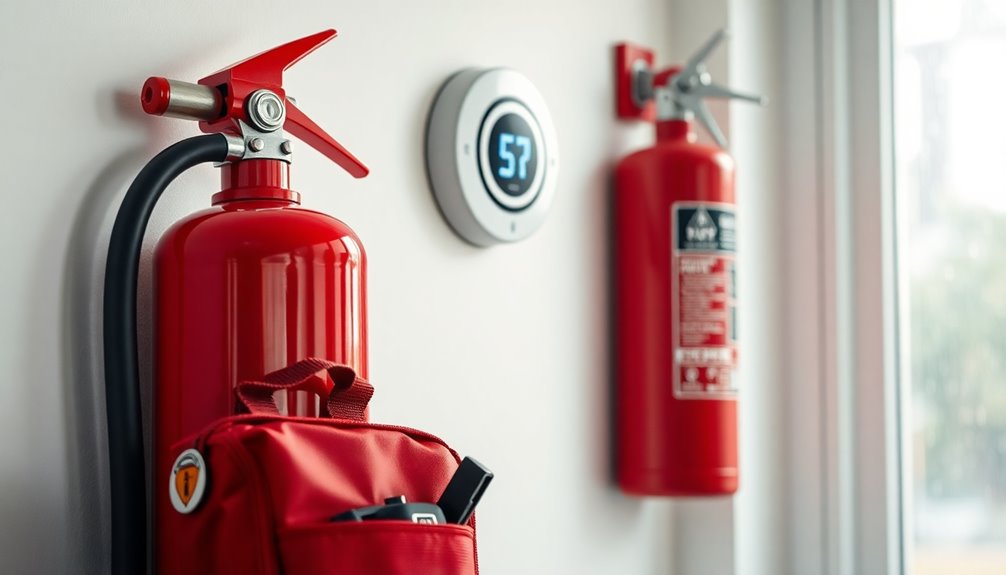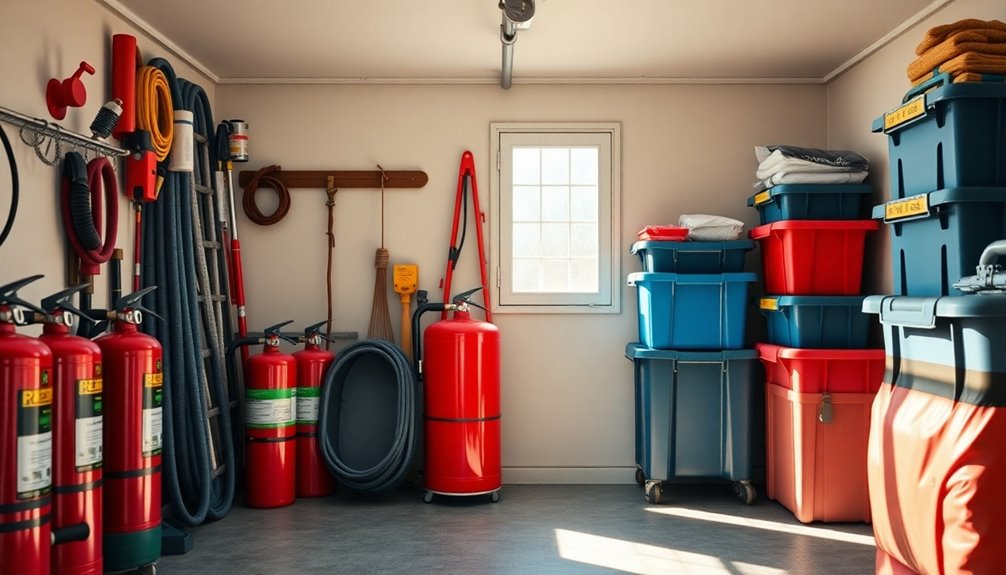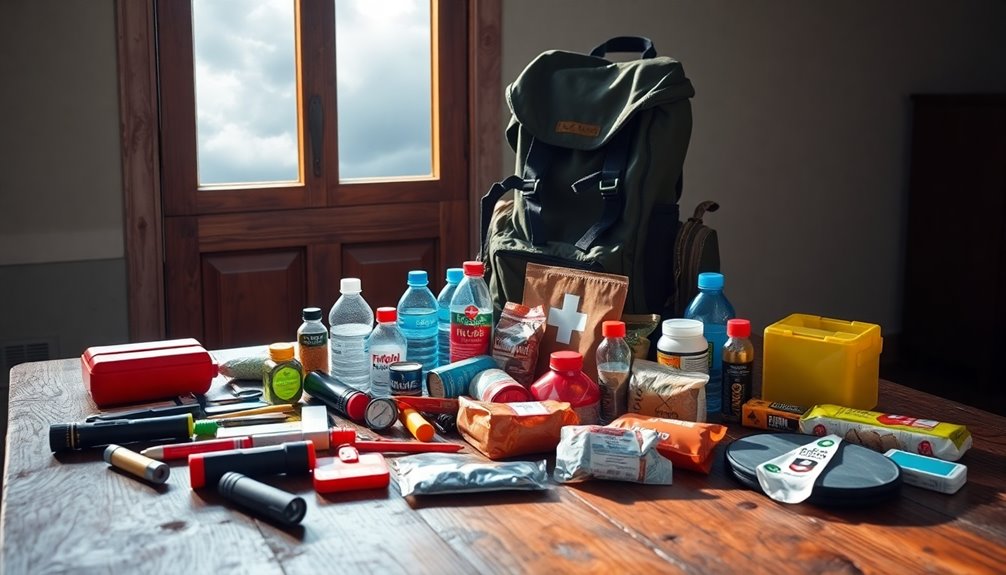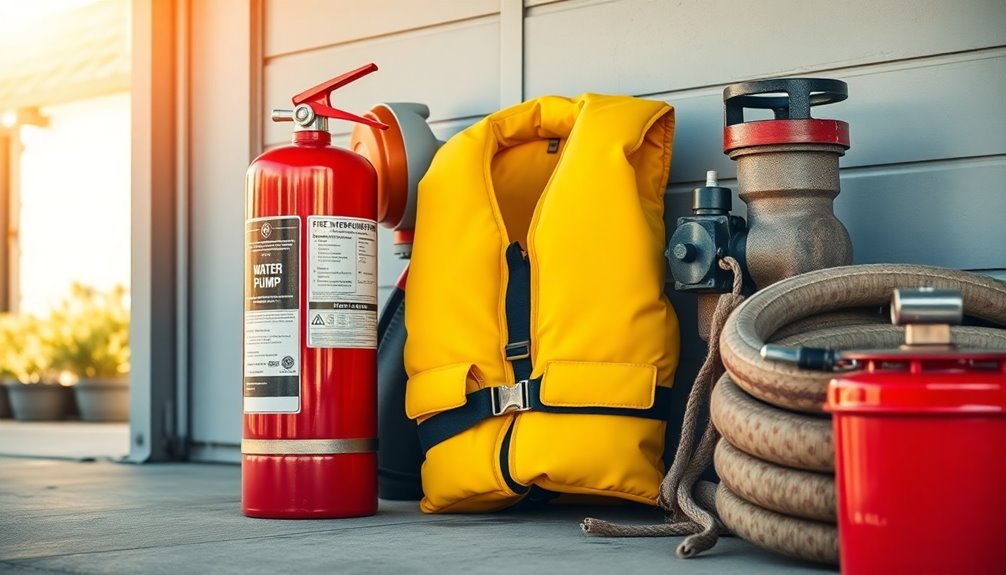To protect your family from fire and flood, equip your home with essential safety tools. Install smoke alarms on every level and guarantee you have accessible fire extinguishers. Regularly maintain these devices. For flood readiness, create an emergency kit stocked with food, water, and first aid supplies. Know your evacuation routes and practice your family's emergency plans regularly. Utilize structural measures like backflow valves and waterproofing to reduce damage risks. Stay informed about local hazards and weather alerts. By taking these proactive steps, you'll enhance your family's safety and resilience when facing potential disasters. There's more to learn about effective strategies.
Key Takeaways
- Install smoke alarms on every level and inside sleeping areas; test them monthly to ensure functionality.
- Create an emergency kit with essentials like food, water, first aid supplies, and clothing for each family member.
- Use fire extinguishers suitable for various fire types, ensuring they are accessible and that family members know how to use them.
- Develop and practice a family communication and evacuation plan, identifying multiple routes and safe meeting points.
- Implement flood control measures like backflow valves and sump pumps to protect your home from potential flooding.
Essential Fire Safety Equipment

When it comes to fire safety, preparedness is key to protecting your home and loved ones. One essential component of your fire safety system is smoke alarms. You should install them on every level of your home and inside each sleeping room to guarantee early warning in case of a fire. Choose between battery-powered or hardwired options, but remember to test and maintain them regularly for peak performance. This is crucial because regular battery checks are necessary for functionality.
In addition to smoke alarms, fire extinguishers are vital for controlling small fires before they escalate. Familiarize yourself with the different types of fire extinguishers and their corresponding classes. For instance, Class A extinguishers, marked with a green triangle, handle ordinary combustibles like wood and paper. Class B extinguishers, marked with a red square, tackle flammable liquids. If you face an electrical fire, use a Class C extinguisher, identifiable by a blue circle. Finally, Class D extinguishers, marked with a yellow star, are necessary for combustible metals.
Make sure these fire safety tools are easily accessible and visible in your home. Training on how to use them effectively is important, as it can make a significant difference in an emergency situation.
Installation and Maintenance Tips

To guarantee your fire and flood systems work effectively, proper equipment placement is essential. You should also establish a regular maintenance schedule to catch any issues before they escalate. By staying proactive, you can help safeguard your property against potential disasters. Additionally, consider using self-deploying flood barriers like the Stingray™ Water Dam, which can be quickly set up around your property perimeter for added protection during flood events.
Proper Equipment Placement
Proper equipment placement is vital for guaranteeing safety and readiness in the face of fire and flood emergencies. You need to install fire protection equipment, such as extinguishers and alarms, according to building regulations and manufacturer specifications. Make sure these devices are easily accessible and clearly visible. It's important to mark the locations of fire escapes, exits, and main corridors so everyone can find them quickly in an emergency.
For flood-prone areas, elevate critical equipment like transformers and electrical cabinets above the expected flood level. Avoid placing these items in basements or other vulnerable spots. Ascertain that vents from tanks extend above the anticipated flood height to prevent damage.
Keep emergency exit signs and fire safety plans visible, and confirm fire extinguishers are in designated areas for easy identification. Document the locations of fire protection equipment and communicate this information to all occupants. Additionally, ensure that you have a plan for regular maintenance of your equipment, as high-quality maintenance is essential for optimal function and compliance. Finally, regularly inspect and maintain your flood barriers, storing them properly for quick deployment during emergencies. By following these guidelines, you'll enhance your family's safety and readiness against fire and flood threats.
Regular Maintenance Schedule
A regular maintenance schedule is essential for guaranteeing your fire and flood protection systems function effectively. For your fire sprinkler system, conduct monthly inspections to visually check gauges, confirm water pressure, and inspect alarm valves for damage. Quarterly, assess the air and water pressure on dry systems, test mechanical devices, and check hydraulic nameplates. At least once a year, inspect pipework, perform a complete system test, and verify that all components meet NFPA 25 standards. It is also crucial to ensure that all inspections and tests are documented to maintain compliance with local fire codes.
For flood protection, focus on interior preparations by using water-resistant materials and applying sealants around windows and doors. Make certain plumbing systems comply with code requirements and install backup sump pumps and water alarms. Outside, grade your lot for proper drainage, extend downspouts, and guarantee roofs drain effectively.
Consider landscaping solutions like rain barrels and rain gardens to manage runoff. By sticking to this maintenance schedule, you'll enhance your family's safety from fire and flood risks, guaranteeing that your systems are always ready when you need them most. Regular checks and preventative measures can save lives and protect your home from disaster.
Key Flood Preparation Strategies

Flood preparation is essential for protecting your home and loved ones. Start by understanding your flood risk. Contact your local county geologist to find out if you live in a flash-flood or landslide-prone area. Familiarize yourself with your community's emergency plans, warning signals, and evacuation routes.
Next, secure your home. Install backflow valves to prevent floodwaters from entering your drains. Elevate electrical components at least 12 inches above projected flood levels and retrofit your appliances to minimize potential damage. Have a flood emergency plan in place to ensure everyone knows what to do when a flood threatens.
Creating an emergency supply kit is vital. Stock it with essentials like food, water, first aid supplies, and clothing. Don't forget to include items for your car.
Finally, stay alert for flood alerts. Gather your supplies and tune into local news for updates. If evacuation becomes necessary, turn off utilities and secure outdoor possessions. Additionally, it’s important to have an emergency plan in place for you and your family. This includes recognizing signs of weather changes, such as darkening skies or sudden drops in temperature, which may indicate an approaching storm. Keep a portable charger handy for your devices and ensure everyone knows where to meet if separated during the evacuation process.
Here's a quick reference table for your flood preparation strategies:
| Preparation Strategy | Action Items |
|---|---|
| Assess Flood Risk | Contact local authorities, know evacuation routes |
| Prepare Your Home | Install backflow valves, elevate electrical components |
| Create an Emergency Kit | Stock essentials like food, water, and first aid supplies
Effective Flood Control Methods

Implementing effective flood control methods can greatly reduce the risk of water damage to your property. Start by installing flood vents that allow floodwater to flow freely through crawlspaces or garages, reducing pressure buildup. Seal foundation and basement walls with mortar or hydraulic cement to close any cracks. Waterproofing compounds on basement walls can prevent seepage, while sump pumps with backup power guarantee continued operation during outages.
Consider flood barriers, like watertight shields around doors and windows, to block water entry. Temporary solutions such as sandbags or inflatable bladder dams can also be useful. The Water Gate system offers rapid response, stabilizing with floodwater pressure, while the Water Inflated Property Protector (WIPP) creates a heavy barrier against incoming water. Installing backflow prevention valves is crucial, as they prevent floodwater from entering through drains and sewer connections.
For drain management, install backflow prevention valves to stop floodwater from entering through sewer connections. Keep floor drains clear, direct downspouts away from your foundation, and use flood-proof covers on sewer openings. With these methods in place, you'll strengthen your home's defenses and minimize potential flood damage.
Creating Emergency Kits

When creating your emergency kit, make certain you include essential items like water, food, and a first aid kit. You'll also want to establish a family communication plan to guarantee everyone knows how to stay in touch during a crisis. Being prepared can make all the difference when disaster strikes. Additionally, ensure your kit includes non-perishable food items to sustain your family in case of an emergency.
Essential Kit Items
Creating an emergency kit is crucial for guaranteeing your safety during unpredictable disasters like fires and floods. You need to prepare for various situations, and having the right supplies can make a significant difference. Here are three key items to include in your kit:
- Basic Supplies: Pack at least one gallon of water per person per day for several days, along with non-perishable food that's easy to prepare. Don't forget a flashlight or headlamp with extra batteries, and a battery-powered or hand-crank radio for updates. Accessibility of supplies is essential for effectiveness during crises. It's also important to ensure that your kit includes multi-purpose tools, which can help you manage a variety of tasks during emergencies. Additionally, having a regular maintenance plan for your appliances can prevent them from failing when you need them most. Consider the potential need for financial assistance programs to help cover any unexpected costs during recovery.
- Personal and Medical Items: Verify you have a 7-day supply of prescription medications, over-the-counter drugs, and any necessary medical supplies like glasses or hearing aids. If you have infants or pets, include baby formula, diapers, and pet food. Make sure to monitor your pets for any signs of illness, especially if they have been exposed to stress during the event.
- Tools and Equipment: A multi-purpose tool, manual can opener, and waterproof matches are crucial. Consider packing a whistle to signal for help and duct tape for various needs.
Family Communication Plan
After assembling your emergency kit, the next step is establishing a family communication plan. This plan guarantees everyone knows how to connect before, during, and after a disaster. Start by gathering important contact information, including phone numbers and addresses for family members, schools, and workplaces. Designate an out-of-town contact who can help family members reconnect if local lines are jammed. An effective communication plan should also include programming I.C.E. In Case of Emergency numbers in phones to facilitate quick access.
Here's a simple table to help organize your communication plan:
| Task | Details |
|---|---|
| Emergency Contacts | Collect numbers and emails for all family members. |
| Out-of-Town Contact | Choose someone outside your area for updates. |
| Meeting Places | Agree on local and out-of-town locations to regroup. |
| Communication Method | Use texts, emails, or social media during a disaster. |
Make certain each family member knows how to reach emergency contacts and understands when to call 911. After a disaster, register with the American Red Cross and update your plan regularly. Keep copies of the contact list visible and guarantee everyone practices the communication plan at least once a year to stay prepared.
Developing Family Evacuation Plans

Developing a family evacuation plan is essential for guaranteeing everyone's safety during emergencies. It helps you stay organized and prepared when every second counts. Here are three key steps to include in your plan:
- Identify Evacuation Routes: Map out multiple routes from home, school, and work. Consider traffic patterns and the needs of family members, including pets or individuals with disabilities.
- Designate Meeting Points: Choose a safe location outside your home where everyone can gather if separated. Make sure everyone knows how to get there, whether it's a neighbor's house or a local park.
- Conduct Regular Drills: Practice your evacuation plan through regular drills. This guarantees everyone knows their role and helps identify any issues in your plan. Additionally, regular drills enhance familiarity with emergency procedures, ensuring a smoother response during real situations.
Remember to review and update your plan regularly, especially if new family members join or circumstances change. Communication is key, so guarantee everyone understands the plan and feels confident in their ability to execute it. By developing a thorough evacuation plan, you'll be better prepared to protect your family during emergencies.
Structural Preventive Measures

Structural preventive measures play an essential role in safeguarding buildings against fires and floods. To start, using fire-resistant materials like gypsum board, concrete, and steel in construction can greatly inhibit flame spread. Incorporate fire-rated walls, doors, and ceilings to enhance your building's fire protection. Verify that all components, including ductwork, meet specific fire resistance standards and undergo regular inspections to maintain effectiveness.
Additionally, creating fire barriers and compartments within your building helps contain fires, limiting their spread. Use fire-rated walls and floors to divide areas, and don't forget to implement fire dampers in ductwork to prevent fire from traveling through ventilation systems. Fire barriers are particularly important as they allow for safe evacuation routes during a fire incident.
Installing active fire protection systems, such as sprinklers and smoke detectors, can detect and control fires in their early stages, providing early warnings to occupants. Regular maintenance of these systems is vital for guaranteeing their reliable operation.
Technological Solutions for Safety

While structural preventive measures form a solid foundation for fire and flood safety, technological solutions take these protections to the next level. These innovations enhance your safety and provide peace of mind, allowing you to respond more effectively to emergencies. Here are three key technological tools you should consider:
- Smart Fire Safety Systems: These utilize IoT technology to monitor sprinkler systems remotely. They send real-time alerts for malfunctions or hazards, ensuring you're always informed. Additionally, precision system testing can be conducted using smart technology, further enhancing the reliability of these systems. High vibrational energy can also play a role in creating a proactive safety mindset. Moreover, integrating smart capabilities allows for seamless control and monitoring of safety devices through your smartphone. The incorporation of energy-efficient technology can also enhance the performance of these systems.
- Flood Warning Systems: By monitoring rainfall and water levels, these systems provide timely alerts. They help you stay ahead of dangerous conditions, allowing for early evacuations and better preparation.
- Video Detection and Suppression Systems: Using advanced imaging, these systems can trace fire origins and implement efficient suppression methods, conserving water and minimizing damage.
Incorporating these technological solutions into your fire and flood readiness plan considerably boosts your family's safety. They offer not just protection, but also the ability to react swiftly when it matters most. Embracing these tools makes your home a safer place to live.
Responsible Lifestyle Practices

Your family's safety starts with responsible lifestyle practices that can greatly reduce the risk of fire and flood damage. Begin by installing smoke alarms throughout your home, testing them monthly, and replacing the batteries at least once a year. Make certain everyone knows two escape routes from every room, and practice these routes twice a year. Teach your children to recognize the sound of smoke alarms and what to do when they hear one.
Conduct regular home inspections to identify the best escape routes, guaranteeing windows and doors open easily. Create a floor plan that includes emergency exits and a designated family meeting spot outside the home. Regularly review and update this plan, especially after any changes in your household. Additionally, ensure that you install smoke alarms on every level of your home to maximize safety.
For flood safety, stay informed about local forecasts and know if your home is in a flood-prone area. Assemble an emergency kit that includes essentials for pets, and follow the "Turn Around Don't Drown®" advice to avoid flooded areas. Finally, establish a family communications plan to guarantee everyone knows who to contact if separated during an emergency. By implementing these practices, you can protect your family from potential disasters.
Frequently Asked Questions
How Often Should I Replace Smoke Detectors and CO Alarms?
You should replace smoke detectors every 10 years, or sooner if the manufacturer recommends a 5-year interval. For carbon monoxide alarms, the replacement is typically every 7 to 10 years, depending on the model. Always check the manufacturing date on the back of each alarm to determine its age. Regularly replacing these devices guarantees they work accurately, keeping you and your family safe from potential dangers. Don't forget to test them monthly!
What Should I Include in My Emergency Kit?
When putting together your emergency kit, make sure you include essential supplies like water, non-perishable food, and a flashlight with extra batteries. Don't forget a first aid kit, medications, and personal hygiene items. Also, pack a multi-purpose tool, a whistle, and a manual can opener. Keep copies of important documents, a charged cell phone, cash, and maps handy. Finally, add warm clothing or an emergency blanket to stay comfortable.
Are There Specific Fire Extinguishers for Different Types of Fires?
Did you know that over 70% of residential fires involve ordinary combustible materials? Yes, there are specific fire extinguishers designed for different types of fires. For instance, an ABC powder extinguisher is versatile enough for Class A, B, and C fires, while a CO2 extinguisher works well for electrical and flammable liquid fires. It's essential to choose the right extinguisher based on the potential fire hazards in your environment to guarantee effective fire safety.
How Can I Improve My Home's Flood Resistance?
To improve your home's flood resistance, start by elevating your foundation using stilts or piers. Consider using durable materials like concrete, brick, or marine-grade plywood for construction. Install waterproof membranes and flood-resistant insulation to keep water out. Seal electrical outlets and elevate HVAC systems to protect them. Don't forget to set up external barriers like aluminum flood planks or sandbags, and make certain your drainage system effectively directs water away from your property.
What Local Resources Are Available for Disaster Preparedness Training?
Did you know that nearly 60% of adults feel unprepared for disasters? For local disaster preparedness training, check out resources like NOAA's workshops focused on regional challenges or the Center for Domestic Preparedness, which offers fully funded courses. These workshops include practical exercises tailored to your area's needs. Consider participating in tabletop exercises and online training to enhance your community's readiness and guarantee everyone knows their role during emergencies.
Conclusion
In the end, you might think you're safe from fire and flood just because you have all the right gear. But remember, it's not the tools that protect your family; it's your readiness to act when disaster strikes. So, while you're busy stockpiling equipment, don't forget to actually practice those evacuation plans. After all, it'd be ironic to have everything prepared but find yourself frozen in fear when the flames roar or the waters rise.










